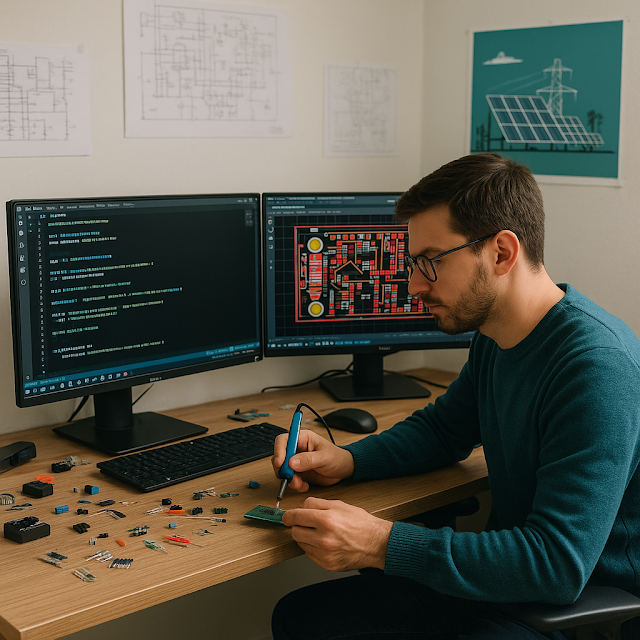This is where Python scripting comes in. By automating various tasks in PCB design, engineers can speed up development, reduce human error, and improve design consistency. Most modern PCB EDA (Electronic Design Automation) tools, such as KiCad, Altium Designer, and EAGLE, offer APIs or scripting interfaces compatible with Python.
In this article, we’ll explore how Python can be used to automate PCB design workflows with practical examples, tools, and FAQs to help you get started.
1. Why Automate PCB Design?
Automation in PCB design solves several real-world issues:
-
✅ Faster iteration for complex or repeated designs
-
✅ Reduced manual errors in placement and routing
-
✅ Consistency across design teams
-
✅ Rule-based automation for DRC (Design Rule Checks)
-
✅ Seamless BOM generation and manufacturing outputs
-
✅ Easy parametric design changes
Automation is not just for large-scale manufacturers; even hobbyists and small design teams can benefit.
2. Overview of EDA Tools Supporting Python
| EDA Tool | Python Support | Type |
|---|---|---|
| KiCad | Yes (via pcbnew API) |
Open-source |
| Altium Designer | Yes (via scripting server) | Proprietary |
| EAGLE | Limited (via ULP scripting, not pure Python) | Proprietary |
| EasyEDA | Limited (cloud API access) | Freemium |
🔧 Note: KiCad offers the most robust Python API out-of-the-box, making it ideal for automation.
3. Python Scripting in KiCad: A Primer
KiCad's scripting interface is built into its pcbnew layout editor and exposes access to:
-
Modules (footprints)
-
Tracks and vias
-
Layers
-
Netlist and components
-
Board dimensions
🛠 Example: Load and Inspect a PCB File
import pcbnew
board = pcbnew.LoadBoard("my_project.kicad_pcb")
print("Number of footprints:", len(board.GetFootprints()))
This script loads a .kicad_pcb file and counts the number of footprints on the board.
4. Common Automation Tasks in PCB Design
Here are common use cases for Python in PCB workflows:
🔹 1. Automatic Component Placement
Place components relative to each other using coordinate rules.
for footprint in board.GetFootprints():
if "R" in footprint.GetReference():
footprint.SetPosition(pcbnew.wxPointMM(50, 50))
🔹 2. Batch Renaming or Labeling
Apply naming schemes to silkscreen text or net labels.
🔹 3. Rule-Based Layout Checks
Perform DRC checks on spacing, trace widths, or via clearances using Python logic.
🔹 4. Netlist Parsing and Manipulation
Modify or validate net connectivity before routing.
🔹 5. Batch Gerber Generation
Automate the export of Gerber and drill files with standardized naming.
plot_controller = pcbnew.PLOT_CONTROLLER(board)
plot_controller.OpenPlotfile("TopLayer", pcbnew.PLOT_FORMAT_GERBER, "Top layer")
🔹 6. BOM (Bill of Materials) Automation
Generate a BOM with custom filters (e.g., exclude test points).
5. Sample Python Automation Scripts
📌 Script: Align All Capacitors Along a Grid
import pcbnew
board = pcbnew.LoadBoard("example.kicad_pcb")
x_offset = 30 * 1e6
y_base = 50 * 1e6
gap = 5 * 1e6
index = 0
for fp in board.GetFootprints():
if fp.GetReference().startswith("C"):
fp.SetPosition(pcbnew.VECTOR2I(x_offset + index * gap, y_base))
index += 1
pcbnew.SaveBoard("output.kicad_pcb", board)
📌 Script: Highlight Violated Nets
for net in board.GetNetsByName():
if net.GetNet().GetLength() > 5000000: # 5 meters in internal units
print(f"Warning: {net.GetNetname()} exceeds recommended length")
6. Integration with BOM, DRC, and Manufacturing
Python can extend your PCB design process beyond layout:
-
BOM generation: Use
pandasto create filtered Excel/CSV files -
DRC scripting: Define custom rules and flag violations
-
Version control: Auto-commit changes to Git with scripts
-
3D Modeling: Export footprint locations for enclosure integration
Example: Generate a BOM in .xlsx
import pandas as pd
data = {"Reference": ["R1", "C1"], "Part Number": ["10K", "100nF"]}
df = pd.DataFrame(data)
df.to_excel("BOM.xlsx", index=False)
7. Benefits and Limitations
✅ Benefits:
-
Scales well for large projects
-
Saves time and reduces fatigue
-
Encourages reusability of design blocks
-
Supports design for manufacturing (DFM)
⚠️ Limitations:
-
Learning curve for APIs
-
Scripting access may vary between EDA tools
-
Debugging can be complex without UI feedback
8. FAQs
Q1: Which EDA tool is best for Python automation?
KiCad is currently the best for open-source Python scripting. Altium has scripting capabilities but requires licensing and COM server setup.
Q2: Can I write routing algorithms with Python?
Yes, but it’s complex. You can place vias and tracks, but full autorouting requires geometric algorithms and constraint solvers.
Q3: Is this only useful for large PCBs?
No! Even small boards benefit from automated component placement, BOM generation, and design checking.
Q4: Can I automate schematic capture?
KiCad v6+ allows some schematic automation via schematic APIs, though it's less mature than layout scripting.
Q5: What skills do I need to start?
Basic Python skills and familiarity with your EDA tool’s scripting environment. No need to be an expert in Python to automate repetitive tasks.
9. Conclusion
Python scripting for PCB design automation is a game-changer for engineers. It enables you to build faster, smarter, and more reliable designs with minimal repetitive effort. Whether you're working on hobby electronics or high-volume manufacturing, automating your PCB workflow with Python gives you a competitive edge.
Start small: write a script that moves all resistors to a grid or generates your BOM automatically. Over time, build a library of reusable scripts to streamline your design process.

